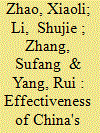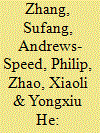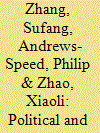|
|
|
Sort Order |
|
|
|
Items / Page
|
|
|
|
|
|
|
| Srl | Item |
| 1 |
ID:
150715


|
|
|
|
|
| Summary/Abstract |
Along with China's rapid industrialization and urbanization, challenges in reducing pollution and CO2 emissions are increasing. One of the major approaches to coordinate economic growth and environmental protection is to substitute coal-fired power with renewable energy. Since 2003, in order to promote wind power development, China has put in place many support policies which fall into either price policy category or non-price policy category. By using a variable intercept and mixed regression model with provincial panel data during 2001–2013, we analyzed the impacts of both categories on the increase of installed capacity in areas with different wind resources. We found that price policy and two non-price policies had positive impacts on the increase of wind power installation, price policy played a greater role than non-price policy did in promoting wind power development, and price policy was more effective in areas with poor wind resources, whilst non- price policy was more effective in areas with rich wind resources. Built on these findings, conclusions and policy recommendations are provided at the end of the paper.
|
|
|
|
|
|
|
|
|
|
|
|
|
|
|
|
| 2 |
ID:
121344


|
|
|
|
|
| Publication |
2013.
|
| Summary/Abstract |
More than 40% of China's total CO2 emissions originate from the power industry. The realization of energy saving and emission reduction within China's power industry is therefore crucial in order to achieve CO2 emissions reduction in this country. This paper applies the autoregressive-distributed lag (ARDL) co-integration model to study the major factors which have influenced CO2 emissions within China's power industry from 1980 to 2010. Results have shown that CO2 emissions from China's power industry have been increasing rapidly. From 1980 to 2010, the average annual growth rate was 8.5%, and the average growth rate since 2002 has amounted to 10.5%. Secondly, the equipment utilization hour (as an indicator of the power demand) has the greatest influence on CO2 emissions within China's power industry. In addition, the impact of the industrial added value of the power sector on CO2 emissions is also positive from a short-term perspective. Thirdly, the Granger causality results imply that one of the important motivators behind China's technological progress, within the power industry, originates from the pressures created by a desire for CO2 emissions reduction. Finally, this paper provides policy recommendations for energy saving and emission reduction for China's power industry.
|
|
|
|
|
|
|
|
|
|
|
|
|
|
|
|
| 3 |
ID:
104977


|
|
|
|
|
| Publication |
2011.
|
| Summary/Abstract |
With economic development and the change of industrial structure, industrial relocation is an inevitable trend. In the process of industrial relocation, environmental externality and social cost could occur due to market failure and government failure. Little attention has been paid to this issue. In this paper, we address it with a theoretical analysis and an empirical investigation on the relationship between China's industrial relocation in the early 1990s and energy consumption which is the primary source of CO2 emission, an environmental externality that causes increasing concerns. The macro-policy analysis suggests that there would be a positive link between China's industrial relocation in the early 1990s and energy saving (and environmental externalities reduction). Using fixed-effect regression model and simulation method, we provide an empirical support to this argument. In order to further reduce environmental externalities and social cost in the process of industrial relocation, we provide policy suggestions as follows: First, strengthen the evaluation of environmental benefits/costs; Second, pay more attention to the coordinated social-economic development; Third, avoid long-lived investment in high-carbon infrastructure in areas with industries moved in; Fourth, address employment issue in the areas with industries moved out.
|
|
|
|
|
|
|
|
|
|
|
|
|
|
|
|
| 4 |
ID:
125724


|
|
|
|
|
| Publication |
2013.
|
| Summary/Abstract |
This paper analyzes China's policy approach to renewable energies and assesses how effectively China has met the ideal of appropriate interactions between renewable energy policy and renewable energy industrial policy. First we briefly discuss the interactions between these two policies. Then we outline China's key renewable energy and renewable industrial policies and find that China's government has well recognized the need for this policy interaction. After that, we study the achievements and problems in China's wind and solar PV sector during 2005-2012 and argue that China's policy approach to renewable energies has placed priority first on developing a renewable energy manufacturing industry and only second on renewable energy itself, and it has not effectively met the ideal of appropriate interactions between renewable energy policy and renewable energy industrial policy. Lastly, we make an in-depth analysis of the three ideas underlying this policy approach, that is, the green development idea, the low-carbon leadership idea and indigenous innovation idea. We conclude that Chinas' policy approach to renewable energies needs to enhance the interactions between renewable energy policy and renewable energy industrial policy. The paper contributes to a deeper understanding of China's policy strategy toward renewable energies.
|
|
|
|
|
|
|
|
|
|
|
|
|
|
|
|
| 5 |
ID:
115122


|
|
|
|
|
| Publication |
2012.
|
| Summary/Abstract |
The traditional strict planning system that regulates China's power market dominates power industry operations. However, a series of market-oriented reforms since 1997 call for more decentralized decision-making by individual market participants. Moreover, with the rapid growth of wind power in China, the strict planning system has become one of the significant factors that has curtailed the generation of wind power, which contradicts with the original purpose of using the government's strong control abilities to promote wind power development. In this paper, we first present the reasons why market mechanisms are important for large-scale utilization of wind power by using a case analysis of the Northeast Grid, and then we illustrate the impact of conflicts between strict planning and market mechanisms on large-scale wind power utilization. Last, we explore how to promote coordination between markets and planning to realize large-scale wind power utilization in China. We argue that important measures include implementing flexible power pricing mechanisms instead of the current fixed pricing approach, formulating a more reasonable mechanism for distributing benefits and costs, and designing an appropriate market structure for large-scale wind power utilization to promote market liquidity and to send clear market equilibrium signals.
|
|
|
|
|
|
|
|
|
|
|
|
|
|
|
|
| 6 |
ID:
121289


|
|
|
|
|
| Publication |
2013.
|
| Summary/Abstract |
This paper identifies and explains how political and institutional factors have determined the relative successes and failures of China's wind power policy over the period 2005-2011. It finds that China has made significant progress in pursuing its wind power policy in terms of cumulative installed capacity, wind turbine manufacturing industry development and wind turbine cost, and argues that these achievements can be attributed to the political motives and institutional arrangements of the Chinese government as well as to institutional changes. On the other hand, the paper finds that there are two prominent policy failures, namely the low proportion of grid-connected capacity and the rising trend of wind turbine incidents. These have undermined the efficiency and effectiveness of China's wind power program. The paper holds that the institutional sources for the first policy failure lies in the preference for setting wind power development targets in terms of installed capacity rather than generation and in coordination problems while the second policy failure lies in the lack of state technical codes for wind power integration and the unfair competition from the large state-owned power companies. The paper contributes to the academic literature on the political and institutional roles in China's wind power policy.
|
|
|
|
|
|
|
|
|
|
|
|
|
|
|
|
| 7 |
ID:
111369


|
|
|
|
|
| Publication |
2012.
|
| Summary/Abstract |
Residential energy consumption (REC) is the second largest energy use category (10%) in China and urban residents account for 63% of the REC. Understanding the underlying drivers of variations of urban REC thus helps to identify challenges and opportunities and provide advices for future policy measures. This paper applies the LMDI method to a decomposition of China's urban REC during the period of 1998-2007 at disaggregated product/activity level using data collected from a wide range of sources. Our results have shown an extensive structure change towards a more energy-intensive household consumption structure as well as an intensive structure change towards high-quality and cleaner energy such as electricity, oil, and natural gas, which reflects a changing lifestyle and consumption mode in pursuit of a higher level of comfort, convenience and environmental protection. We have also found that China's price reforms in the energy sector have contributed to a reduction of REC while scale factors including increased urban population and income levels have played a key role in the rapid growth of REC. We suggest that further deregulation in energy prices and regulatory as well as voluntary energy efficiency and conservation policies in the residential sector should be promoted.
|
|
|
|
|
|
|
|
|
|
|
|
|
|
|
|
| 8 |
ID:
126563


|
|
|
|
|
| Publication |
2013.
|
| Summary/Abstract |
China's wind power is in an embarrassing state. Along with its dramatic development since 2005, its curtailment ratio has been rising. Although this could be attributed to both physical and institutional factors, it is the institutional obstacles, mainly resulting from the adjustment difficulties of interests distribution, that have exercised a greater impact. The stakeholders relating to wind power integration are thermal power companies, grid companies and local governments. The extent to which wind power deployment affects these vested interests determines the core institutional obstacles to be addressed. Mainly based on quantitative and case analyses, we argue that currently wind deployment in China has a little impact on the interests of thermal companies, moderate impact on the interests of grid companies and great impact on local governments. We recommend that it is crucial to elevate the role of environmental protection and renewable energy increase while de-emphasize the role of economic growth in the evaluation of local governments' performance, as well as provide incentives for grid companies to attend more to their social responsibilities rather than their scale expansion and revenue growth.
|
|
|
|
|
|
|
|
|
|
|
|
|
|
|
|
| 9 |
ID:
094243


|
|
|
|
|
| Publication |
2010.
|
| Summary/Abstract |
Despite the fact that China's energy intensity has continuously decreased during the 1980s and mostly 1990s, the decreasing trend has reversed since 1998 and the past few years have witnessed rapid increase in China's energy intensity. We firstly conduct an index decomposition analysis to identify the key forces behind the increase. It is found that: (1) the high energy demand in industrial sectors is mainly attributed to expansion of production scale, especially in energy-intensive industries; (2) energy saving mainly comes from efficiency improvement, with energy-intensive sectors making the largest contribution; and (3) a heavier industrial structure also contributes to the increase. This study also makes the first attempt to bridge the quantitative decomposition analysis with qualitative policy analyses and fill the gap between decomposition results and policy relevance in previous work. We argue that: (1) energy efficiency improvement in energy-intensive sectors is mainly due to the industrial policies that have been implemented in the past few years; (2) low energy prices have directly contributed to high industrial energy consumption and indirectly to the heavy industrial structure. We provide policy suggestions in the end.
|
|
|
|
|
|
|
|
|
|
|
|
|
|
|
|
| 10 |
ID:
112931


|
|
|
|
|
| Publication |
2012.
|
| Summary/Abstract |
The asymmetry of Chinese coal and electricity pricing reforms leads to serious conflict between coal suppliers and electricity utilities. Electricity utilities experience significant losses as a result of conflict: severe coal price fluctuations, and uncertainty in the quantity and quality of coal supplies. This paper explores whether establishing cooperative relationships between coal suppliers and electricity utilities can resolve conflicts. We begin with a discussion of the history of coal and electricity pricing reforms, and then conduct a theoretical analysis of relational contracting to provide a new perspective on the drivers behind the establishment of cooperative relationships between the two parties. Finally, we empirically investigate the role of cooperative relationships and the establishment of mine-mouth power plants on the performance of electricity utilities. The results show that relational contracting between electricity utilities and coal suppliers improves the market performance of electricity utilities; meanwhile, the transportation cost savings derived from mine-mouth power plants are of importance in improving the performance of electricity utilities.
|
|
|
|
|
|
|
|
|
|
|
|
|
|
|
|
|
|
|
|
|